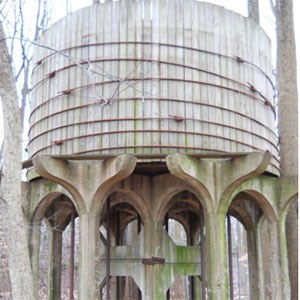
NPS photo
The National Capital Region (NCR) contains abandoned mineral lands (AML) from historic and past underground and surface mining. NCR has 59 features in 4 parks: Chesapeake and Ohio Canal National Historical Park (CHOH, 38), George Washington Memorial Parkway (GWMP, 6), National Capital Parks-East (NACE, 4), and Prince William Forest Park (PRWI, 11) all in the NPS AML database. NCR has had hazards, contaminants, historic features, and threatened and endangered species associated with former gold, iron, lime, and pyrite mines and rock quarries.
Many sites in NCR have been reclaimed such as Cabin Branch at PRWI and Ford Mine in CHOH. In PRWI, the Greenwood Gold Mine had pits filled in 2003-2005 and mercury contaminated soil removed. The reclamation efforts have also negatively impacted the extant foundation ruins of mine structures and require stabilization so they are not destroyed. Other sites are fenced and or have warning signs to protect visitors and historic features such as the CHOH Maryland Mine. Bat gates have been placed on openings in Maryland Mine and the Round Top Mine, which is used by the federally endangered Indiana bat. Some sites still remain impacted by historic quarrying such as Windy Run and Dyke Marsh in GWMP. For example, at Windy Run, mining removed a significant amount of rock, decreasing lateral support compared to natural areas. Six slides of shallow debris avalanches originated at the top of quarried rock faces and involved the zone of weathered rock and soil.
Regional Priorities for Site Restoration
Preservation
- Wildlife Issues—NCR has the federally endangered Indiana bat present as well as state-listed bats;these species are a major wildlife concern. With the deadly White Nose Syndrome (WNS) in Round Top Mine complex, we protect and monitor hibernating bats in mine shafts in cooperation with the Maryland Department of Natural Resources. Additionally, there are state-listed invertebrates present. Warning signs about falling rocks are needed at the bat gates.
- Landscape Resilience—Dyke Marsh had 490 acres of wetland habitats lost or impacted by extensive dredging and subsequent accelerated erosion. Congress mandated the restoration of tidal freshwater wetlands and associated ecosystems in Dyke Marsh (P.L. 93-251). GWMP is in the final stages of a restoration plan/EIS. Funding is available for the restoration of the marsh lands according to the preferred alternative, except for revegetation. After the hydrology is reestablished, native species must be planted to stabilize the restored land.
- Cultural Resources—Maryland Mine has cultural features that could be restored such as the blacksmith shop and mill. A water tower is intact (Figure 1), but slats are loose, and a tree recently hit and remains on the structure. These structures could be repaired and made safe for visitor interpretation. Round Top Mine has 8 lime kilns and a masonry chimney from a historic cement factory. The kilns and chimney need to be stabilized and further interpretation could be provided. The fences need to be maintained or upgraded.
Reclamation vs Restoration
- NCR would like to mitigate issues and features at sites to remove any hazards to human health and safety. Those that are culturally significant should be restored and interpreted.
- Landslide hazards in GWMP require mitigation.
Pressing Needs
The most pressing needs for abandoned mine reclamation at NCR are:
- CHOH Maryland Mine (BD-01, BD-02, BD-03) —Water tower, blacksmith shop, and assay office "mill". Stabilize/restore/secure the structures;interpret for the visitor. NEED: Provide appropriate and safe access.
- CHOH Maryland Mine (SH-01, SH-02, SH-03) —Partially collapsed shafts. Danger of underground collapse. NEED: Maintain/upgrade existing fences and warning signs.
- CHOH Round Top Mine (ST-03, ST-04, ST-05) —Lime kilns, brick chimney, brick walls. Potential collapse hazard. Highly accessible site. Features should be inspected for structural integrity, stabilized as necessary, and interpreted to the public. NEED: Inspect features for structural integrity, stabilize as necessary, and interpret for the public.
Last updated: February 8, 2016
